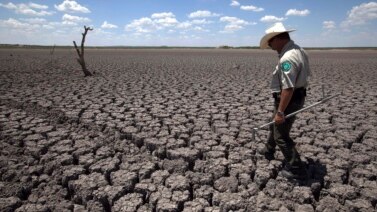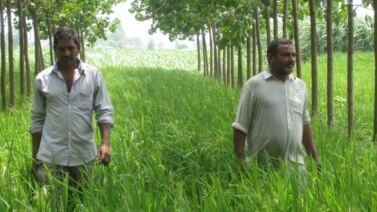As the weather cools across the United States, a growing number of Americans visit farms. They harvest apples, enjoy hay wagon rides and walk in the fields. These people are called “agri-tourists.” They improve the economy of rural areas and help farmers increase their profits.
"Here! This way!"
"That way!"
School children are walking in a corn field maze. The corn is cut into tricky passageways that make it difficult to find a way out.
"No!"
The children are from Yorktown Elementary School in Bowie, Maryland. They have traveled to Montpelier Farms in Prince George’s County, which is also in Maryland. The farm is about 40 kilometers from The White House.
Debbie Pierson is the student’s teacher.
“We go on these kind of field trips so that the children will have a hands-on experience of what it’s like to be on a farm.”
“This is a good one.”
“Yeah.”
“Yeah.”
Amy Etsy-Smith is visiting the farm with her children.
“We come about once a year. Lots of fun, yes. The kids enjoy it. This was her favorite part, was choosing the pumpkin.”
When Mike Dunn opened the family farm to agri-tourists in 2008 he had only a corn maze, a pumpkin field and hay wagon rides. But he says so many people visited that he soon increased the number of activities. He says he hopes he will someday make a larger profit from visitors than from farming.
“Our agri-tourism revenue might be 30 percent of our entire farm income. We’d like to grow it to maybe one day be 60 percent.”
Americans spent more than $700 million on agri-tourism activities in the United States in 2012. That is an increase of 24 percent from 2007.
“Buddy” Hance is Maryland’s agriculture secretary.
“Farm operators who have these operations generate (a) significant portion of their income from this opportunity. So it’s a great revenue stream for the county, states and the farmers.”
In Loudon County, Virginia, there are farms where grapes are grown for use in making wine. Many of the farms let people visit, and drink the wine that is made there. Bill Hatch owns the Zephaniah Farm Vineyard. He holds wine tastings in his home.
“We’re doubling the number of visitors to our farm every year. We have an average of 250 people on a weekend.”
As more people visit farms, more farmers are adding activities in which visitors can take part. Malcolm Baldwin owns WeatherLea Farm and Vineyard in Loudoun County. Six years ago, he began letting people be married at his farm. They can also sleep at the farm overnight. Mr. Baldwin says the money he makes from these activities let him keep his small farm operating.
“But without the animals, and without the vines, the wedding business wouldn’t be as profitable because people like to see the vines. They like to see the animals, and without which I don’t think this would be as popular a place.”
I’m Caty Weaver.
This story was reported by correspondent June Soh from Prince George’s County, Maryland. Christopher Cruise wrote it for VOA Learning English and produced the program. Caty Weaver edited and read it.
Words in This Story
tourist – n. a person who travels to a place for pleasure
maze – n. a complicated and confusing system of connected passages
field trip – n. a visit to a place (such as a museum or zoo) that is made by students to learn about something
harvest – v. to gather (a crop)
wine – n. an alcoholic drink made from the juice of grapes
overnight – adv. for or during the entire night
Now it’s your turn to use these Words in This Story. In the comments section, write a sentence using one of these words and we will provide feedback on your use of vocabulary and grammar.

